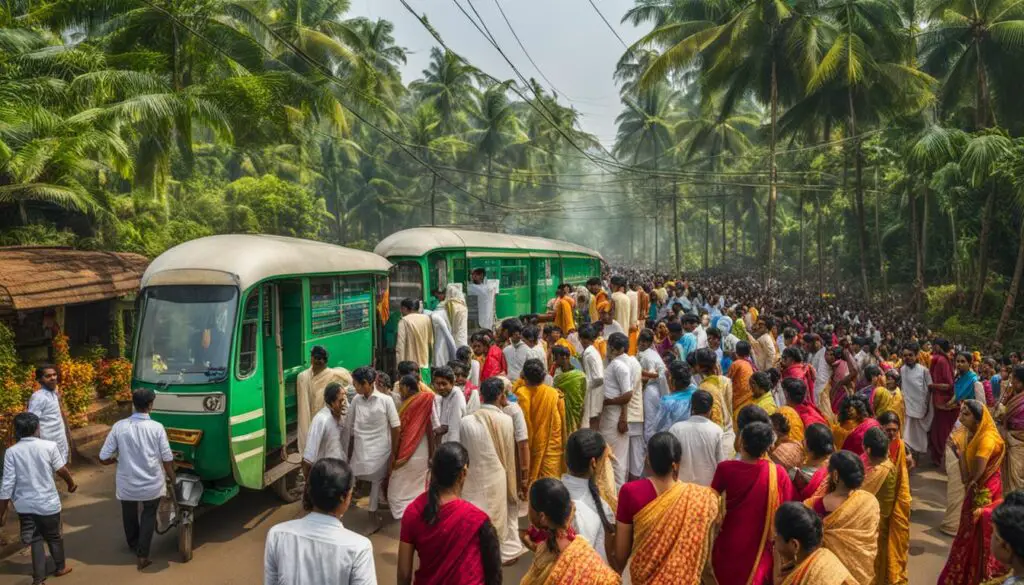The Kerala model of development is a unique and successful approach to socio-economic progress in the Indian state of Kerala. Kerala stands out for its high development indicators, including high literacy rates, low birth rates, and excellent healthcare. It is known for its focus on education, healthcare, and social welfare, which have contributed to its overall development and well-being of its citizens. The state’s development outcomes are comparable to those of the most developed countries, making the Kerala model an inspiration for other regions and nations.
Key Takeaways:
- The Kerala model of development has resulted in high development indicators such as literacy rates, birth rates, and healthcare.
- Education, healthcare, and social welfare are the pillars of Kerala’s development strategy.
- The Kerala model serves as an inspiration for other regions and nations looking to achieve sustainable socio-economic progress.
- Investing in education, healthcare, and social well-being is crucial for sustainable and inclusive development.
- Kerala’s development outcomes are comparable to those of the most developed countries.
Factors Contributing to the Kerala Model of Development
Several factors have played a crucial role in the success of the Kerala model of development. Kerala is blessed with abundant natural resources and breathtaking landscapes, which have served as a catalyst for its thriving tourism industry. Visitors are drawn to Kerala’s pristine backwaters, lush green hills, and serene beaches, contributing significantly to the state’s economic growth. One cannot overlook the positive impact of Kerala’s natural beauty on its overall development.
Another notable factor is the state’s high literacy rates. Kerala boasts one of the highest literacy rates in India, with both men and women having access to quality education. This emphasis on education has not only fostered an intellectually empowered society but has also facilitated effective communication with tourists from around the world. Well-educated individuals in Kerala excel in the tourism industry, providing exceptional services to visitors and attracting investments in educational institutions and cutting-edge technology.
The stability of governance in Kerala has also been instrumental in the state’s development. With its efficient Panchayat Raj system, Kerala has managed to implement policies and programs that prioritize the well-being of its people. The state government comprises highly educated ministers who are dedicated to sustainable socio-economic growth. Their commitment to good governance has created an environment conducive to progress and development.
Kerala’s natural resources, high literacy rates, stable governance, and flourishing tourism industry have been the cornerstone of the Kerala model of development.
The following table summarizes the key factors contributing to Kerala’s successful development model:
| Factors | Description |
|---|---|
| Natural Resources | Kerala’s abundant natural resources, including pristine backwaters, lush green hills, and serene beaches, have fueled its thriving tourism industry. |
| High Literacy Rates | Kerala boasts one of the highest literacy rates in India, resulting in a highly educated and qualified workforce, crucial for the growth of various sectors, including tourism. |
| Stable Governance | The stable governance in Kerala, supported by an efficient Panchayat Raj system, has created a favorable environment for sustainable socio-economic growth. |
| Tourism Industry | Kerala’s flourishing tourism industry has been a major catalyst for economic development, attracting visitors from around the world and generating employment opportunities. |
Image: Kerala’s natural beauty attracts tourists and drives the tourism industry.

In the next section, we will explore the impact of the Kerala model of development on the state’s overall development, quality of life, and social progress.
The Impact of the Kerala Model of Development
The impact of the Kerala model of development can be seen in the remarkable progress the state has achieved in various areas, leading to improved quality of life and social progress. Through its focus on providing quality education, healthcare facilities, and social welfare programs, Kerala has achieved impressive development outcomes that rival those of the most developed countries.
Quality Education for All
One of the key aspects of the Kerala model is its commitment to providing quality education to all its citizens. With a high literacy rate and well-established educational institutions, Kerala has empowered its population with knowledge and skills. This has not only enhanced the employability of its workforce but has also fostered an environment of continuous learning and innovation.
Healthcare for All
Another significant area of development in Kerala is its healthcare system. The state has pioneered initiatives to ensure that every citizen has access to quality healthcare services. As a result, Kerala has achieved higher life expectancy rates and lower infant mortality rates compared to other regions in India. The availability of well-equipped hospitals and primary healthcare centers has greatly contributed to improving the overall health and well-being of the population.
Social Welfare Programs
Kerala’s commitment to social welfare is evident through its comprehensive social welfare programs. These programs aim to uplift marginalized communities, alleviate poverty, and provide opportunities for socio-economic growth. The state has focused on empowering women by promoting gender equality and providing them with access to education, employment opportunities, and participation in decision-making processes. This has resulted in remarkable social progress and increased representation of women in various sectors.
The transformative impact of the Kerala model of development can be summarized by the improved development outcomes and enhanced quality of life in the state. The focus on education, healthcare, and social welfare has not only improved literacy rates and life expectancy but has also fostered inclusivity and gender equality. Kerala’s success serves as a testament to the possibilities of sustainable and inclusive development, inspiring other regions and countries to adopt similar approaches.
“The impact of the Kerala model of development can be seen in the remarkable progress the state has achieved in various areas, leading to improved quality of life and social progress.”
| Development Outcomes | Quality of Life | Social Progress |
|---|---|---|
| High literacy rates | Higher life expectancy | Promoting gender equality |
| Low birth rates | Lower infant mortality rates | Empowering marginalized communities |
| Excellent healthcare | Improved overall health | Enhanced socio-economic growth |

Conclusion
The Kerala model of development has emerged as a successful approach to socio-economic progress, with its emphasis on factors such as abundant natural resources, high literacy rates, stable governance, and a focus on social welfare. The state’s impressive development outcomes, including high life expectancy, low birth rates, and remarkable human development indicators, rival those of the most developed countries.
By prioritizing education, healthcare, and social well-being, Kerala has set an example for other regions and countries. Its model showcases the importance of investing in these essential areas for sustainable growth and improved quality of life. The success of Kerala in achieving socio-economic progress serves as an inspiration for nations striving for comprehensive development and inclusive growth.
With its commitment to education, healthcare facilities, and social welfare programs, Kerala has not only uplifted the lives of its citizens but also fostered gender equality. Women in the state enjoy access to education, employment opportunities, and decision-making processes, showcasing the transformative impact of the Kerala model.
The Kerala model of development stands as a testament to the tremendous possibilities when a state focuses on holistic growth. By replicating and adapting the principles of the Kerala model, other regions and countries can create their own path to success, contributing to socio-economic progress and enhanced well-being for their populations.
FAQ
What is the Kerala model of development?
The Kerala model of development is a unique and successful approach to socio-economic progress in the Indian state of Kerala. It is known for its focus on education, healthcare, and social welfare, which have contributed to its overall development and well-being of its citizens.
What are the factors contributing to the Kerala model of development?
Several factors have contributed to the success of the Kerala model of development. These include the state’s abundant natural resources and scenic landscapes, high literacy rates, stable governance, and a thriving tourism industry.
What is the impact of the Kerala model of development?
The impact of the Kerala model of development can be seen in the state’s development outcomes and improved quality of life. Kerala has achieved remarkable progress in various areas, including healthcare, education, and overall social well-being. It has higher life expectancy, lower infant mortality rates, and improved literacy rates compared to other regions.
Why is the Kerala model of development an inspiration for other regions and countries?
The Kerala model of development serves as an inspiration for other regions and countries because it demonstrates the importance of investing in education, healthcare, and social welfare for sustainable growth and improved quality of life. It showcases that socio-economic progress can be achieved even with limited resources.
How does the Kerala model contribute to gender equality?
The Kerala model of development has contributed to gender equality by providing women in the state with access to education, employment opportunities, and decision-making processes. This has empowered women and promoted their participation in various sectors of society.
